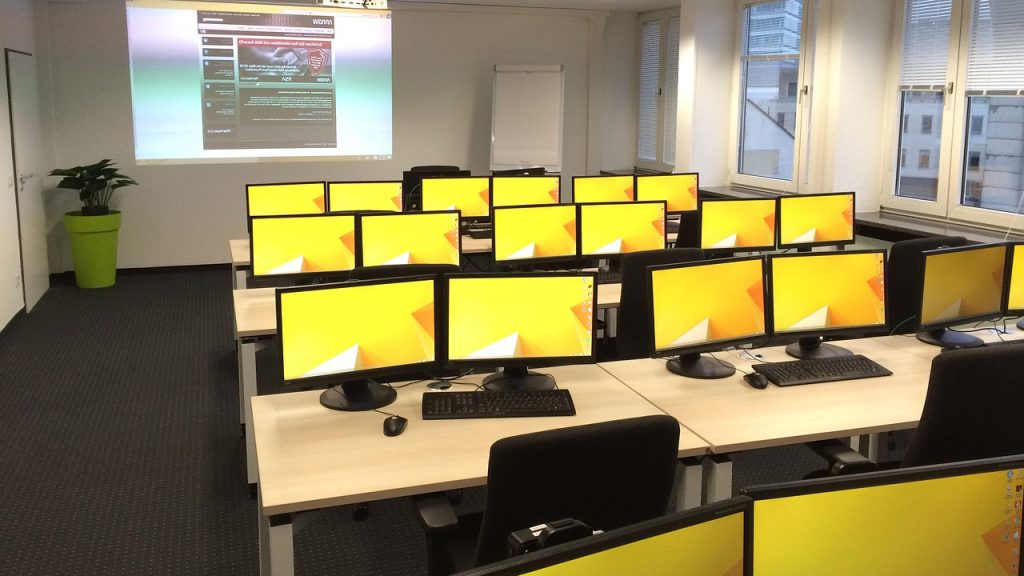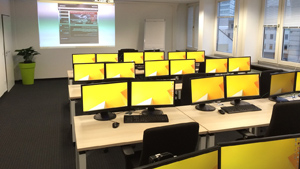As technology continues to revolutionize various industries, its impact on education cannot be overlooked. Computers have become an integral part of classrooms around the world, transforming the way students learn and educators teach. In this article, we will explore how computers are used in education and the benefits they bring.

Photo by wipperfuerth on Pixabay
Advantages of using computers in education
Computers in education offer numerous advantages that enhance the learning experience for students. One significant advantage is the access to a vast amount of information. With the internet at their fingertips, students can conduct research and explore subjects beyond the confines of traditional textbooks. This not only broadens their knowledge but also helps develop critical thinking and problem-solving skills. The ability to access up-to-date information empowers students to stay informed and engage with a variety of perspectives.
Another advantage is personalized learning. With various educational software and online platforms, students can progress at their own pace and receive individualized feedback. This ensures a more personalized and effective learning journey. Adaptive learning programs can tailor content to the student’s needs, identifying areas of strength and weakness. This approach helps students build confidence and overcome challenges, leading to improved academic performance.
Computers also promote creativity and collaboration. Students can engage in group projects, sharing ideas and working together in real-time. Collaborative software allows for seamless communication and document sharing, fostering teamwork and developing essential interpersonal skills. Interactive learning games and simulations make education more engaging and enjoyable, sparking creativity and curiosity in students.
Types of computer-based learning tools
In the modern education landscape, a wide range of computer-based learning tools are available to enhance the learning process. One popular tool is educational software, which includes interactive programs and applications designed to support specific subjects or skills. For example, mathematics software can provide practice exercises, tutorials, and real-time feedback to help students improve their problem-solving abilities.
Another type of learning tool is virtual reality (VR) technology. VR immerses students in virtual environments, allowing them to explore historical sites, perform science experiments, or even visit outer space. This technology brings abstract concepts to life, making learning more memorable and engaging.
Online learning platforms have gained popularity, offering courses and resources on various subjects. These platforms provide flexibility, allowing students to learn at their own pace and from anywhere with an internet connection. They often include interactive elements such as quizzes, discussion forums, and video lectures to enhance the learning experience.
Computer applications in classroom instruction
Computers have significantly transformed classroom instruction, enabling educators to adopt innovative teaching methods. Interactive whiteboards and projectors have replaced traditional chalkboards, allowing teachers to display multimedia content, diagrams, and videos. This visual aid enhances student engagement and understanding.
Educational software and online resources provide teachers with a wealth of materials to support their lessons. Teachers can create interactive presentations, design quizzes, and access educational videos to supplement their teaching. These resources save time and effort, enabling educators to focus on individual student needs and provide personalized instruction.
In addition to content delivery, computers facilitate assessment and grading. Online testing platforms allow teachers to create quizzes and exams, automatically grade them, and provide instant feedback to students. This streamlined process saves time and ensures accuracy in evaluating student knowledge and performance.
Online learning platforms and virtual classrooms
The rise of online learning platforms and virtual classrooms has revolutionized education, particularly in remote or distance learning scenarios. Online learning platforms provide a wide range of courses, allowing students to pursue their interests or acquire new skills. These platforms often include interactive elements such as discussion forums, chat rooms, and live Q&A sessions, fostering a sense of community and collaboration among learners.
Virtual classrooms take this concept a step further by simulating a traditional classroom environment in a virtual space. Students and teachers can interact in real-time through video conferencing, chat, and shared whiteboards. This format allows for real-time discussions, group activities, and presentations, creating an immersive and engaging learning environment.
Online learning and virtual classrooms offer flexibility and convenience, enabling students to access education regardless of their location or schedule. This approach has become particularly relevant during the COVID-19 pandemic, where traditional classroom settings were disrupted, and remote learning became the norm.
Computer-assisted assessment and grading
Computers have revolutionized the assessment and grading process in education. Computer-assisted assessment tools allow for automated scoring of exams, quizzes, and assignments, reducing the time and effort required for manual grading. These tools often employ algorithms that analyze student responses and provide instant feedback on performance, highlighting areas of improvement and reinforcing learning objectives.
Computer-assisted assessment ensures consistency and fairness in grading. The use of predetermined rubrics and criteria eliminates subjective bias, ensuring that all students are evaluated based on the same standards. This approach promotes transparency and helps students understand their strengths and weaknesses in a more objective manner.
Computer-based assessment also allows for data collection and analysis, providing educators with valuable insights into student performance and learning patterns. This data-driven approach enables educators to identify areas for improvement, adapt teaching strategies, and provide targeted interventions to support student success.
Accessibility and inclusivity in computer-based education
Computers in education have the potential to improve accessibility and inclusivity for students with diverse learning needs. Assistive technologies, such as screen readers, speech recognition software, and alternative input devices, enable students with disabilities to access educational content and participate in classroom activities. These technologies level the playing field, allowing students to overcome physical barriers and fully engage in the learning process.
Computer-based education provides flexibility in terms of pace and learning style. Students who require additional time or alternative approaches to learning can benefit from personalized learning tools and accommodations. Adaptive software can adjust the difficulty level and provide additional support, ensuring that all students have access to appropriate learning materials and opportunities for success.
It is essential to recognize that accessibility challenges still exist. Not all educational platforms and content are designed with accessibility in mind, which can create barriers for students with disabilities. Educators and developers must prioritize accessibility standards and guidelines to ensure that computer-based education is truly inclusive and equitable for all learners.
Challenges and limitations of computer use in education
While computers offer numerous benefits in education, they also present certain challenges and limitations. One significant challenge is the digital divide, referring to the unequal access to technology and the internet among different communities and socioeconomic groups. Students without access to computers or reliable internet connection face barriers in participating in computer-based education, putting them at a disadvantage. B
ridging the digital divide requires concerted efforts from governments, educational institutions, and technology providers to ensure equal access to technology and connectivity for all students.
Another challenge is the potential for distraction and misuse of technology in the classroom. With access to the internet, social media, and entertainment, students may become easily distracted during class time, hindering their focus and learning outcomes. Educators must implement strategies to minimize distractions and promote responsible use of technology, such as establishing clear guidelines and providing guidance on digital etiquette.
The rapid pace of technological advancements poses a challenge in terms of keeping up with the latest tools and trends. Teachers need adequate training and professional development opportunities to effectively integrate computers into their instructional practices. Continuous learning and adaptation are crucial to harnessing the full potential of technology in education.
Future trends in computer-based education
As technology continues to advance, the role of computers in education is set to evolve further. One emerging trend is the integration of artificial intelligence (AI) in educational software and platforms. AI-powered tools can analyze student data, identify learning patterns, and provide personalized recommendations for improvement. This adaptive learning approach ensures that students receive tailored support and resources based on their individual needs.
Another future trend is the incorporation of augmented reality (AR) and virtual reality (VR) technologies in the classroom. AR and VR provide immersive experiences, enabling students to interact with virtual objects and environments. This technology has the potential to revolutionize fields such as science, engineering, and medicine by allowing students to visualize complex concepts and practice real-world skills in a safe and controlled environment.
The increasing focus on data-driven decision-making in education will continue to shape computer-based education. Educators can leverage data analytics to gain insights into student performance, engagement, and learning outcomes. This information can inform instructional strategies, curriculum design, and personalized interventions, ultimately improving the quality of education.
The transformative role of computers in education
Computers in education have revolutionized the learning process, making it more interactive, personalized, and engaging for students. The advantages of using computers in education include access to a vast amount of information, personalized learning experiences, and opportunities for creativity and collaboration.
Computer-based learning tools, online platforms, and virtual classrooms have expanded educational opportunities, particularly in remote learning scenarios. Computers have also transformed classroom instruction, assessment, and grading, streamlining processes and providing valuable data for analysis.
While challenges and limitations exist, efforts to bridge the digital divide, promote responsible use of technology, and provide professional development opportunities can overcome these obstacles. Looking ahead, future trends such as AI, AR, VR, and data-driven decision-making will shape the future of computer-based education. As technology continues to advance, the transformative role of computers in education will continue to shape the future of learning.




